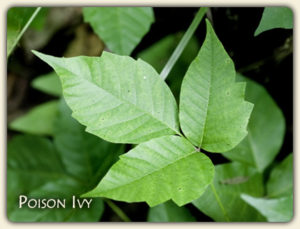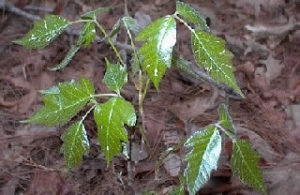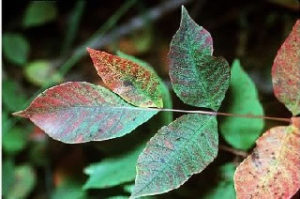When you are weeding your garden, you need to be very careful about the plants you touch. Although we call them poison ivy, poison oak, and poison sumac, these plants of the Toxicodendron species are not really poison. They do contain an allergen, urushiol, which can cause contact dermatitis in those who are susceptible.
People who have allergies to related plants such as cashew, mango and ginkgo should be aware of an increased cross-reactivity to urushiol producing plants.
The most common plant dermatitis in the USA is caused by poison ivy and/or poison oak. The allergic reaction caused by contact with poison ivy afflicts more than 70% of the human population, with as many as 350,000 cases reported annually in the United States alone. It is an important environmental hazard in natural environments and the agroecosystem, as well as urban environments and military deployments.
Skin reactions can include blisters and rashes. The oil spreads readily to clothes and then back to skin again. The urushiol oil can stay active on any surface, including clothing, shoes, dead plants, garden tools, fishing poles, etc., for up to five years. Infections can follow scratching. Even the smoke of burning poison ivy can cause reactions in the lungs and can be fatal.
If you come in contact with any of the Toxicodendron plants, it is important to rinse the urushiol oil off the skin with copious amounts of water within 20 minutes of exposure before it binds with the membrane lipids of the skin. Do not use soap.
Soaps can spread the urushiol oil around the skin and worsen the dermatitis, so washcloths should be used with soap, and this washing should be preceded and followed by copious irrigation of all contacted skin.
Oral steroids like prednisone or methylprednisolone may be beneficial in the treatment of moderate to severe cases. Oral antihistamines and topical steroids may improve itching. Domeboro, calamine, oatmeal baths, and Burrow’s solution (aluminum acetate) are topical solutions that have been proven to reduce irritation.
You should learn to recognize poison plants:
POISON IVY

Poison Ivy typically grows in the form of a woody vine that attaches itself to trees or other objects for support, often along riverbanks. In full sun, it can grow as an upright shrub without support. The entire plant is poisonous, leaves, stems, and roots.
Each shiny leaf has three leaflets. This leaf cluster grows on its own stem with two side leaflets directly opposite and a third in the middle with a longer stem. The veins of each leaflet generally alternate along the main vein. The leaf forms can vary even on the same plant. The leaf margins can be smooth, wavy, lobed, or toothed. Poison Ivy has no thorns. Small flowers appear in the summer. White, waxy fruits attached in clusters on slender stems, develop in late summer or fall. Leaves have yellow or red fall color that begins to turn in early fall, but still can cause a rash even when the leaves are dead.
POISON OAK

This plant grows in the form of a shrub and has 3 leaves similar to poison ivy. Poison oak is mostly found on the West Coast. Though a form of poison ivy with leaves that resemble oak, is often mistaken for poison oak.
POISON SUMAC

Poison Sumac grows as a woody shrub or small tree. Each stem contains 7 to 13 smooth-edged, oval leaves arranged in pairs. The leaves turn a bright red in the fall and are green throughout the rest of the year. During the spring poison sumac often produces small, whitish-yellow or pale green flowering buds, which turn into white berries in the late summer and fall. Many people mistakenly call the leaf form that resembles oak leaves ‘poison oak’.
Staghorn sumac is a non-poisonous cousin of similar appearance with jagged-edged leaves and red berries, which grows in Maryland.
Before you touch any plants growing in your garden, know what they are and do not let them contact your skin. Wear long sleeves, long pants, gloves and a mask to protect yourself in the garden.

